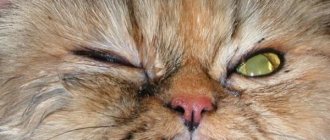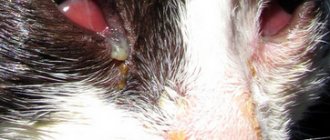Tearfulness, purulent formations in the corner of the eyes, inflammation of the eyelids and obvious anxiety of the animal associated with the eyes - such symptoms cannot but alert the responsible owner. Self-treatment in such cases is unacceptable, since the exact diagnosis is unknown. Most often, the owner thinks that the cat has ordinary conjunctivitis, but only a veterinarian can make a diagnosis.
The symptoms described above are characteristic not only of conjunctivitis. Similar manifestations may be accompanied by an inflammatory process in the cornea of the eye. A cat may also develop blepharitis, a dangerous disease whose advanced cases lead to partial or complete loss of vision.
Blepharitis in a cat
Causes of the disease
Blepharitis refers to inflammation of the edges of the eyelids. There are several types of the disease. The most common are simple (scaly), ulcerative, and meibomian.
There can be many reasons that cause blepharitis in cats:
- Viruses and bacteria, most often pyogenic cocci.
- Helminthic infestations.
- Subcutaneous mites. In this case, in addition to the eyelids, the neck and face of the animal are affected.
- Pathogens (fungi) of trichosporia and microsporia.
- Allergic reaction of the body to food, pollen, etc.
- Eye injuries received during a fight or as a result of self-scratching.
- Seborrhea. When the functions of the sebaceous glands are disrupted, dandruff and scales appear on the eyelids.
- Autoimmune and endocrine pathologies.
- Violation of hygiene standards.
And this is not a complete list of factors that provoke such an unpleasant eye disease as blepharitis.
Fusion of eyelids
Cause. Eyelid fusion in a cat can be either congenital or acquired. Owners notice congenital fusion of the eyelids after the birth of a kitten. Acquired fusion in a cat occurs after injuries to the head and eyes, with chronic blepharitis, chemical and thermal burns of the eyelids.
Clinical picture. During a clinical examination, the veterinarian cannot separate the eyelids, there is a continuous strip of skin between the eyelids, and there is a scar between the fused eyelids.
Treatment. Surgical intervention aimed at separating the eyelids.
Main symptoms
Signs of blepharitis vary depending on the form of the disease, but there are also common symptoms - swelling and redness of the eyelids, watery eyes, itching. These phenomena cause discomfort to the cat; it constantly scratches its eyes and thereby becomes even more injured.
Scaly blepharitis is characterized by redness and swelling of the eyelids, and thickening of their edges. At the site where eyelashes grow, gray scales form, from which pus begins to ooze over time. As the disease progresses, eyelash loss may occur.
Ulcerative blepharitis is usually a consequence of scaly blepharitis. After the crusts of pus dry out and fall off, ulcers form in their place, through which infection enters the body. After some time, the affected areas heal and the skin tightens.
Thus, the cat develops an inversion or inversion of the eyelid, which does not completely close the eyes. Eyelashes don't grow. In severe cases of the disease, hair loss or thinning may be observed.
The cause of meibomian blepharitis is increased secretion of secretions from the glands. This leads to redness and thickening of the edge of the eyelid, suppuration.
Eversion
The pathology is characterized by excess free space between the eyeball and the lower eyelid. Visually, the edge of the base of the eyelashes is turned outward, as well as the exposed conjunctiva.
The reasons are:
- genetic predisposition;
- tumor formations;
- weakness of the eyelid muscles;
- facial nerve paralysis.
The symptoms of the disease are as follows:
- redness of the conjunctiva;
- profuse lacrimation;
- inflamed cornea;
- drooping eyelid.
The disease is treated surgically.
Diagnostics in a veterinary clinic
Diagnosis of the disease includes taking an anamnesis, examining with a slit lamp, studying clinical signs, and the necessary laboratory tests (washes, scrapings, blood tests, biopsy of eyelid tissue). It is important to differentiate blepharitis from other ophthalmological pathologies and to identify the factor that provoked a decrease in immunity.
Third eyelid prolapse
Prolapse of the third eyelid in a cat is often a secondary symptom of a number of infectious and parasitic eye diseases; it occurs when the optic nerve becomes inflamed.
Clinic. Cat owners and veterinary specialists use eyelids, which sometimes reach up to 1/3 of the entire visual area.
Treatment. Third eyelid prolapse in cats can be treated symptomatically or surgically. Treatment should be aimed at eliminating the primary disease that led to the loss of the third eyelid. Surgical treatment involves surgical excision of the prolapsed third eyelid.
Treatment method and prognosis
Treatment of blepharitis is complex and carried out under the direct supervision of a veterinarian. Therapy is aimed at eliminating the root cause.
When the disease is caused by the activity of microorganisms, a course of immunoglobulins and antibiotic therapy is prescribed; if it is caused by viruses, then antiviral drugs will be required.
If a subcutaneous mite is detected, relief from blepharitis will take many months, since the animal will also have to be treated for sarcoptic mange or demodectic mange. In this case, precautions should be taken - these diseases are classified as zooanthroponoses and are transmitted to humans.
If the disease develops against the background of a fungal infection, then treatment will also be protracted. Trichophytosis goes away in 2 weeks with the help of three-time vaccination and fungicidal ointments, but microsporia is more difficult to cope with. The use of antibiotics in the form of ointments and injections, the introduction of antibacterial emulsions and suspensions will be required.
For blepharitis of allergic origin, it is necessary to make adjustments to the diet, take antihistamines, and eliminate the source of the allergy.
To treat the eyes, special ointments and gels, antibacterial drops (Saphrodex, hydrocortisone, Betnazol) are used.
The drug "Iris" has proven itself well. Dosage - 1-3 drops depending on the weight of the animal.
Immediately before using them, the edges of the eyelids are disinfected with brilliant green and alcohol-ether. Oletethrin, gentamicin, syntomycin (1%) and methyluracil (10%) suspensions are injected into the conjunctival sac.
Scales and crusts must be softened and removed using saline solution and Vaseline ointment.
It is very important that the cat does not rub or scratch its eyes - this will worsen the course of the disease. To prevent her from harming herself further, a protective collar is placed around her neck, which she will have to wear until her recovery.
In case of inversion, eversion, or closure of the eyelids, an operation is performed followed by follow-up treatment.
If therapy is started in a timely manner, the prognosis for blepharitis is favorable.
How to treat conjunctivitis in cats?
Treatment begins with an initial examination of the thin lining of the cat's eyeballs and the inside of the eyelids. The mucous membrane of the upper eyelid (conjunctiva) in a cat resembles a pad. There are many ducts of the lacrimal glands here.
Functions of the ducts:
- Do not allow the eye to dry out.
- Wash away any small particles that get into your eyes.
If you look closely at the inner corners of a cat's eyes, you'll see another layer of mucus. When inflamed, it becomes especially noticeable. This is conjunctivitis - an inflammatory process of the conjunctiva that protects the eye.
What to do at home
A caring owner must provide the pet with complete peace and proper living conditions. Under no circumstances should you select medications on your own, since very often blepharitis is confused with conjunctivitis.
The owner, bypassing going to the veterinary clinic, buys the drops himself, washes the animal’s eyes with herbal infusions and strong tea, but for some reason nothing helps. This is not surprising, because they are treating him for one disease, but he needs to fight something completely different. And often such self-medication leads to very unpleasant consequences and complications, including loss of vision.
Traditional medicine methods can be used, but they should not replace drug treatment prescribed by a veterinarian. It is advisable to use various herbal decoctions (chamomile, calendula, St. John's wort, sage), "Fitoelite" phytolotions, and wash your eyes with a decoction of hyssop.
Phytomineral feeding will also not be superfluous. It is also necessary to strengthen the immune system so that the body has the strength to fight the disease.
Prevention of blepharitis
Proper nutrition and an active lifestyle strengthen the animal’s body. To boost immunity, it is useful to give vitamin and mineral supplements.
Try to protect your pet from contact with stray and sick animals. Wash your hands when coming from outside. Put outer clothing and shoes in the closet (they can bring infection into the house).
Animal Eye Problem? How to treat?
Drafts and prolonged hypothermia have an adverse effect (especially on kittens). A healthy cat does not need to clean or rinse its eyes, but it is important to monitor their condition regularly. If a cat's eyelid becomes inflamed, this is a reason to immediately contact a veterinarian.
All information posted on the site is provided in accordance with the User Agreement and is not a direct instruction to action. We strongly recommend that before using any product, you must obtain a face-to-face consultation at an accredited veterinary clinic.
Dacryocystitis
Dacryocystitis is an inflammation of the lacrimal sac, accompanied by a violation of the patency of the nasolacrimal canal due to its narrowing.
Cause. The disease in cats occurs as a result of chronic conjunctivitis.
Clinic. During a clinical examination, a veterinarian notes mucous or purulent discharge from the eyes of a sick cat. In the outer upper corner of the eye orbit, a swelling is visible, which is painful on palpation. The upper eyelid is swollen, the lacrimal gland is enlarged on palpation. Sometimes there is an accumulation of pus in the tissues around the eyes.
Treatment. Treatment of dacryocystitis in cats can be symptomatic or surgical. Symptomatic treatment consists of relieving inflammation and pain by using novocaine blockades and absorbable ointments (Vishnevsky ointment, ichthyol). Surgical treatment consists of cleaning the lacrimal canal or extirpation of the lacrimal gland.
Keratitis
Keratitis is inflammation of the cornea.
Cause. Keratitis in cats is caused by infectious diseases (infectious rhinotracheitis in cats, feline chlamydia, mycoplasmosis in cats, calicivirus infection of cats), helminthic infestations, damage to the cornea by a foreign body, and eye injuries. Often the cause of keratitis can be inflammatory processes in nearby tissues.
Clinic. Keratitis in a cat can be superficial, deep and ulcerative. With keratitis, a cat may experience vision loss. During a clinical examination of a sick animal, a veterinarian notes redness of the eye, photophobia, clouding of the cornea, pain, and visible blood vessels. Cloudiness of the cornea occurs due to cellular infiltration (by leukocytes) and changes associated with cell swelling, their degenerative decay, as well as changes in the intercellular connective tissue. The intensity of turbidity can be different and depends on the density and nature of the infiltrate or edema in the interstitial tissue. The gray-smoky color of the cloudiness is formed by a small accumulation of leukocytes. With an increase in the number of leukocytes, the color of the cornea becomes white; a yellowish tint characterizes a purulent infiltrate. The opacification may be diffuse or limited to isolated areas in the form of dots or spots in the anterior layers (superficial keratitis) in the parenchyma (parenchymal keratitis). If the surface layers are damaged, the cornea loses its specular properties and becomes matte. With keratitis, vascularization of the cornea also occurs (ingrowth of blood vessels into the cornea). At the same time, during a clinical examination, the veterinarian notes a pericorneal injection, which is characterized by overflow of densely located vessels in the limbus area. The reaction from the conjunctiva, mainly its scleral part, is manifested by edema and hyperemia. With keratitis, experts note a reaction from the iris. The membrane becomes hyperemic, the pupil narrows, and serous, fibrinous or purulent exudate sometimes appears in the anterior chamber. With acute keratitis, a cat experiences photophobia, spasm of the eyelids, lacrimation and pain. In eosinophilic keratitis, veterinarians upon clinical examination detect the presence of white plaques on the cornea that extend from behind to the anterior wall. Slight lacrimation is noted. When performing a cytological examination, we find a large number of eosinophils.
Treatment. Symptomatic treatment is carried out. Eliminate the underlying disease that caused the keratitis. The affected eye is washed with antimicrobial solutions, and eye ointments and drops are used. If a purulent process occurs, antibiotics are used; for deep and ulcerative keratitis, eye microsurgery is used. For eosinophilic keratitis, they resort to the use of immunomodulators and hormones.
Cataract
Cataract is clouding of the lens. The disease often leads the cat to blindness. Cataracts in cats are associated with metabolic disorders in the lens and are accompanied by increased breakdown of protein components.
Cause. Trauma, infectious diseases, and chronic inflammatory eye diseases lead to cataracts in cats.
Clinic. At the last stage of the disease, the cat has difficulty seeing in the affected eye. Upon examination, the lens has a white or bluish color. The dilated pupil does not respond to light.
Treatment. The use of eye drops for cataracts can only slow down the degenerative processes developing in the lens.
Iritis (iridocyclitis)
Iritis (iridocyclitis) is inflammation of the iris and ciliary body.
Cause. Traumatic injury, inflammation spreading from the cornea, complications after eye surgery, infectious diseases.
Clinic. During a clinical examination, a clinic veterinarian notes a constriction of the pupil, dimming of the iris, photophobia, pain, and cloudy fluid in the anterior chamber of a sick cat. When conjunctivitis is associated with the disease, we note serous-purulent discharge.
Treatment. In order to restore pupil contraction, a 1% atropine solution, novocaine blockade, and antibiotics are prescribed. During treatment, eye drops and ointments with anti-inflammatory and antimicrobial effects have a good effect.











